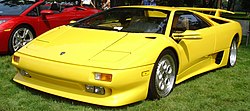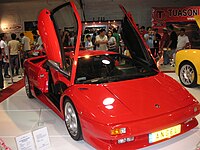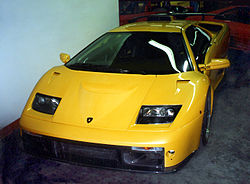














The Lamborghini Diablo was a high-performance mid-engined sports car built by Italian automaker Lamborghini between 1990 and 2001, before it was replaced by the Lamborghini Murciélago.
 | |
| Manufacturer | Lamborghini |
|---|---|
| Production | 1990–2001 2,898 produced |
| Assembly | |
| Predecessor | Lamborghini Countach |
| Successor | Lamborghini Murciélago |
| Class | Sports car |
| Body style(s) | 2-door coupe 2-door roadster |
| Layout | Mid-engine, RWD / AWD |
| Engine(s) | 5.7 L V12 6.0 L V12 |
| Transmission(s) | 5-speed manual |
| Designer | Marcello Gandini |
Diablo
Lamborghini began developing the Diablo (which translates to "Devil" in Spanish) in 1985 as a replacement for the Countach model, introducing it for sale on January 21, 1990 at a base price of USD 240,000. Power came from a 5.7-litre, 48-valve version of the legendary Lamborghini V12 featuring dual overhead cams and computer-controlled multi-point fuel injection, producing a maximum output of 492 hp (367 kW/499 PS) and 427 ft·lbf (579 N·m) of torque. The vehicle could reach 60 mph (97 km/h) in slightly over 4 seconds, with a top speed of 202 mph (325 km/h). The Diablo was originally rear-wheel drive and the engine was mid-mounted to aid its weight balance.
Even at over $240,000, the vehicle was somewhat spartan, featuring only basic radio functions (with optional CD playback) along with manual windows, adjustable but unpowered seats and no anti-lock brakes, mostly to minimize the vehicle's already high curb weight. A few options were available, including having the driver's seat molded specifically for the buyer, a rear spoiler, a factory fitted luggage set (priced at $2,600) and an exclusive Breguet clock for the dash (priced at $10,500).
[edit] Diablo VT (Ver. 1), Diablo VT Roadster and Diablo VT Roadster R
After three years of making minor adjustments to the Diablo, Lamborghini decided in 1993 that a second, even more specialized version of the car could add new customers to the brand. Starting with the basic Diablo platform, Lamborghini engineers added a viscous-coupling type all-wheel-drive system, an improved power steering system, resized front wheels and tires chosen to work better with the all-wheel-drive system, four-piston Brembo brake calipers, an updated dashboard design and a new computerized suspension system featuring aggressively tuned Koni shock absorbers. The suspension system could be left in "auto" mode where it was controlled entirely by the computer, or any of four separate "modes" could be manually selected by the driver via buttons in the cabin. The vehicle still lacked ABS brakes. Lamborghini had presented an open-topped concept version of the VT (Viscous Traction) at the 1992 Geneva Auto Show alongside the coupé when the car debuted there, but it was another 3 years before the model saw production. Other than its removable Targa-style carbon fiber roof panel, the vehicle was essentially identical to the coupé, with only a few minor styling differences, mainly in regards to the tail lights between the two models.
In order to bring additional publicity to their pro-am series in 1997, there was a roadster version of the SVR, called VT Roadster R, despite being based on an SVR chassis with everything that its racecar variant has and lacking the four wheel drive system of the VT.[1]
[edit] Diablo SE30 and Diablo SE30 Jota
A lightened, hard-edged racing variant of the standard Diablo, the SE30 was sold in limited numbers during 1994 to celebrate Lamborghini's 30th anniversary. The 'SE' stands for Special Edition.
In total just 150 cars were made, eight of which were right hand drive (RHD). In 1995 Lamborghini introduced the SE30 Jota; the Jota was produced from the Lamborghini factory but SE30 owners also had the option of having Lamborghini upgrade their SE30 to Jota specifications. The Jota upgrade consisted of two roof mounted air scoops, a re-tuned L.I.E. chip and a six-speed all-synchromesh gearbox if the Diablo was made at the Lamborghini factory. With these upgrades in place the Diablo SE30 Jota could produce 595 bhp, 72 more than the SE30's 523 bhp (390 kW/530 PS). In total only 28 Jota upgrade kits were made but 1 of these was not installed. Contradictory to this, it is believed that only 12 Jotas were actually made (10 in LHD, 2 in RHD); this figure may have come from the number of models made by Lamborghini itself. As an interesting side note about the Jota, Jay Kay (lead singer of Jamiroquai), featured the sound of this car in the intro to a track, called "Travelling without moving" on the band's album of the same name.
The car went without most of the Diablo's standard equipment, meaning that it was devoid of a radio, air-conditioning or sound insulation and featured carbon fiber molded seats, helping to make it 125 kilograms (276 lb) lighter than the standard car. Lamborghini chose to do without the VT's advanced electronic suspension or all-wheel-drive systems, but the car did get an advanced adjustment system controlled with an interior dial that could instantaneously adjust the stiffness of the car's front and rear anti-roll bars. They also enlarged the brake discs of all four wheels, but the car still lacked ABS.
[edit] Diablo SV
The SV or "Sport Veloce" variant of the Diablo was an optional add-on package to the base car. It lacked the VT's all-wheel-drive system and electronic suspension, but it featured the VT's revised dashboard and larger brakes, a new 3-piece adjustable spoiler and was powered by a modified version of the 5.7-litre V12 producing 510 hp (380 kW/517 PS). The car's air intakes were slightly differently shaped, and from 1999 onwards the vehicle had exposed headlamps as opposed to the pop-up units previous versions used.
Tuning company Koenig-Specials of Germany produced a tuned variant of the SV featuring further suspension modifications, massive brakes and a twin-turbocharger system, boosting the car's output to over 800 hp (597 kW/811 PS).
[edit] Diablo SVR
Unveiled at the 1996 Geneva Salon, the SVR variant is a lightweight competition version of the SV, built for its pro-am one make series known as Diablo Supertrophy, which was intended to run for three years, with its inaugural round held as the support race to the 1996 24 Hours of Le Mans.[2]
The SVR is 191 kg (421 lb) less than the SV (1,385 kg (3,053 lb)) and boasts 540 hp (403 kW/547 PS), mainly of a revised fuel injection timing and is the first Diablo to use variable valve timing. There are numerous noticeable cosmetic differences, the covered lights or sometimes is used in place of its usual retractable headlights. Other cosmetic differences includes, a deeper front spoiler, side skirts and a redesigned rear valance. Also the most visible modification is a fully adjustable rear aerofoil, lightweight acrylic side windows are used in place of a glass items and a set of 18-inch OZ Racing one-piece hollow spoke cast magnesium wheels[1] Each car sold, came with a seasons factory support and an entry to the one-make series. All repairs and maintenance was carried out by Lamborghini themselves.[1]
The series first title winner was BPR regular, Thomas Bscher, who became involved with the business side of the brand in later years. In total, 31 versions of this model have been produced altogether.[2] Only a few of these have been modified for road use.[1]
[edit] 1999-2001 Models
[edit] Diablo VT and VT Roadster
The second version of the VT coupé and roadster added mostly cosmetic and styling changes. The cars now featured the SV's exposed headlamps (Borrowed from the Nissan 300zx 1990-96, and Used under licence) , new wheels and a newly redesigned dashboard. On the mechanical side, larger brakes, the addition of ABS brakes and a new variable valve timing system on the 5.7-litre V12 were the only mechanical updates. Power output increased to 530 hp (400 kW/540 PS), The standard 0-100 km/h time was 3.8 seconds but if you rev up to 6000 rpm and sidestep the clutch you can launch it in 3.6 seconds. Despite the money Lamborghini had spent making the updates, the "Version 2" VTs were discontinued after only one year of production.
[edit] Diablo SV
Just like the updated versions of the VT coupé and roadster, the 1999 model year SV's changes were primarily limited to cosmetics. It received slight bodywork updates (keeping the exposed headlamps), new wheels and larger brakes in addition to the new VVT-equipped, 530 hp (400 kW/540 PS) engine. The 1999 Diablos also gained a new dashboard. Instead of the traditional flat dashboard with a separate upright instrument binnacle, as on so many Italian sports cars, the new dash was of a more fluid, wave shaped design. A thin strip of black glass runs the length of the dash, and instruments lights such as main beam, headlight operation and low fuel warning appear within this strip. The concept was inspired by Bang & Olufsen Hi-Fi products.
Otherwise, the 1999 Diablo remained fundamentally unchanged. Like the updated VT, it was produced only as a production model for the 1999 model year. A limited edition 2000 model was produced, available only in metallic silver - most of these cars are in the United States.
[edit] Diablo GT
As much as the SV (Sport Veloce) was already a near race-ready version of the Diablo, the limited run GT model went even further in the same direction. It boasted a modified version of the V12 engine, bored out to 6.0 litres and producing 575 hp (429 kW/583 PS), while enlarged brakes, an improved and lower-riding suspension and owner- ygnacio lamborghini changes. More aggressive bodywork with flared fenders and wider wheels were introduced. Only 80 units were produced in total and the vehicle was only officially sold in Europe.[3]
[edit] Diablo GTR
After campaigning the Diablo SV-R for four years in the Diablo Supertrophy Lamborghini launched a completely new car for the 2000 season. This Diablo GTR is a modified version of the 6 litre GT version of the Diablo launched in 1999. In comparison with the Diablo GT, GTR most important features are a modified chassis frame with integrated roll bar, improved suspensions, central fixing nut for the rims, race braking system, additional radiators for transmission oil cooling, very high performance rear wing (directly bolted to the chassis), simplified interiors and weight reduction. The engine is basically the same V12, 6 litre, of the Diablo GT which thanks to the adoption of a specially tuned exhaust system, without catalyser, delivers 590 hp (440 kW/600 PS) (575 in the GT model).
The engine management system is based on the proprietary Lamborghini LIE electronic engine control system tuned for racing. Fuel injection is sequential multipoint and ignition is static with individual coils. Lamborghini Data Acquisition System, LDAS, and diagnostic functions are integrated in the engine electronic management system.
For the engine cooling, two water radiators in parallel are side mounted to the engine and an engine oil cooler is front mounted as in the Diablo GT. Additional coolers for gearbox and differential oil are installed in order to better match the racing overloads.
The transmission is on the rear wheels through a Lamborghini 5 speed gearbox with one basic gear ratio option and an alternative option for a shorter 5th gear ratio. The gear box lever is in an asymmetric position on the central tunnel in order to be closer to the steering wheel, for better control. The steering system is power assisted.
The tubular chassis frame integrates the roll bar and is directly connected to the rear wing. The front suspension is modified for racing. Shock absorbers and anti-roll bars are adjustable. The rims are lightweight magnesium alloy with central fixing nut and they accept racing type tyres. A special racing fuel tank with fast filling system has been installed. The braking system is based on the Diablo GT high performance module. New racing brake calipers have been adopted to better match the very severe racing conditions.
Most of the body is carbon fibre made, except for the roof, which is made of steel for torsional rigidity, while the doors are made of aluminium, for safety reasons.
The cockpit fittings are simplified to meet racing requirements. The driver seat has been moved towards the longitudinal axle of the car, reducing the size of the central tunnel, to ensure a better driving position. Racing switches for ignition and for other functions have been adopted instead of the series push buttons. The fire extinguisher system is installed on the right side of the cockpit with activating switch on the tunnel. The driver's seat is of racing type with a six-point safety belt and the steering wheel is also racing type.
A production run of 30 cars was planned at the launch of the car at the 1999 Bologna Motorshow, but at the end of the run 40 cars were built.
[edit] Diablo VT 6.0
After Audi AG took over Lamborghini from its former South East Asian owners in 1998, Mycom and VPower, they set out to make major revisions to the Diablo so that it could continue to provide revenue while its replacement was developed. The VT 6.0 was their first (and last) truly intensive redesign of the car, meaning that it was more than just a cosmetic update to the existing model. Heavy styling changes both inside and out were made; the front bumper, air intakes and nose as well as the entire dashboard, seats and switchgear were changed and improved. Displacing 6.0 litres and based on the motor that powered the Diablo GT, which in itself was essentially a modified version of the 5.7, the motor had updated ECU software in addition to new intake and exhaust systems and a refined variable valve timing system with slightly less aggressive camshafts than had been used in the earlier versions.





No comments:
Post a Comment